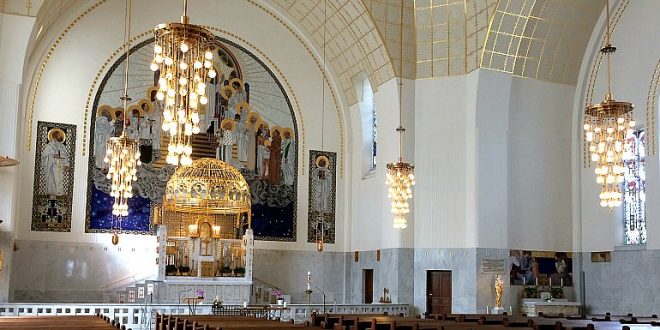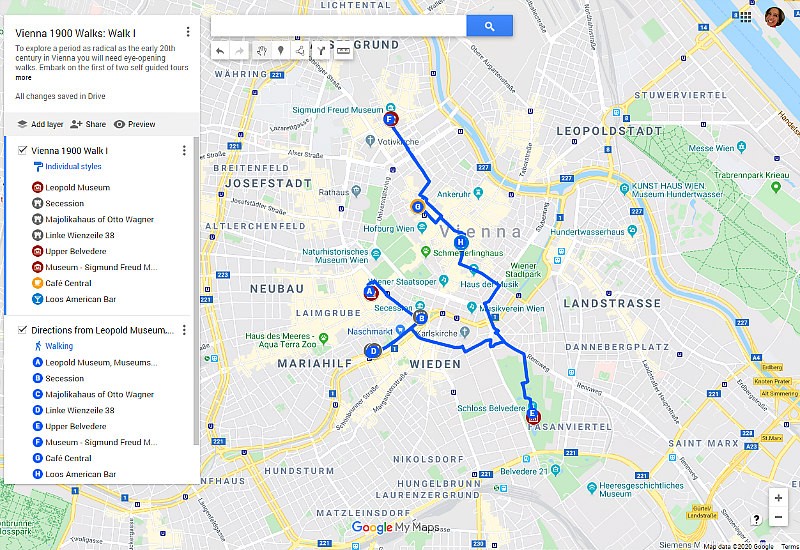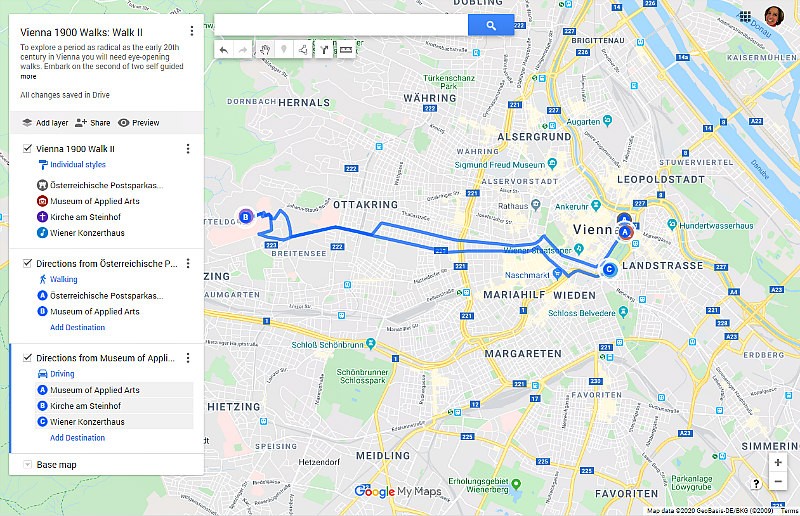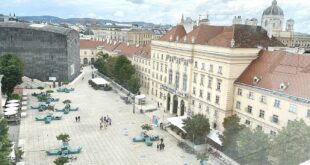To explore radical and complex Vienna 1900 these two in-depth mapped out itineraries cover key buildings, visits of museums, a coffeehouse, a church, a concert hall, and even an American bar. On your way, you will follow the likes of Sigmund Freud, Stefan Zweig, Gustav Klimt, and Otto Wagner. The walks are wrapped in two day itineraries, and include addresses, opening hours and advice on occasional transport. If you’d like to buy gifts, I have also added great Jugendstil shopping tips below.
Vienna 1900: Designing The Viennese Style
“Nothing that is not useful can be beautiful.” (Otto Wagner)
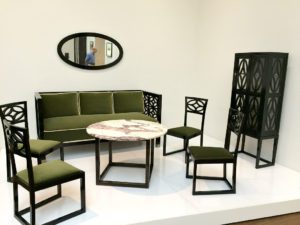 On its journey to modernism, fin-de-siècle Vienna sparked a dozen ground-breaking concepts in art, architecture, design, music, literature and the human psyche. But the Jugendstil movement’s most powerful ideas was to blend these areas into one holistic artwork.
On its journey to modernism, fin-de-siècle Vienna sparked a dozen ground-breaking concepts in art, architecture, design, music, literature and the human psyche. But the Jugendstil movement’s most powerful ideas was to blend these areas into one holistic artwork.
Not enough, artists such as Gustav Klimt, Kolo Moser and Josef Hoffmann committed themselves to uniting art and function. As a result the Viennese ‘Jugendstil’ differs from German, Scottish, French, or Belgian Art Nouveau. Just look at Gustav Klimt’s frieze of Beethoven’s Ninth Symphony, or Otto Wagner’s obsessively functional Austrian Postal Savings Bank.
Vienna 1900: Day 1
Duration of itinerary including museum visits: 8 to 10 hours
You may want to use tramway D for a 10 min ride from Sigmund Freud Museum to Museumsquartier, and from the National Gallery to Café Central, alighting at Burgring and then crossing Heldenplatz and Hofburg.
Sigmund Freud Museum
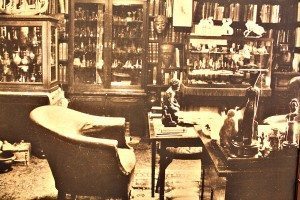 Starting with Freud reminds us that the period of Vienna 1900 wasn’t only architecture, but a world of thoughts. In fact, the father of psychoanalysis and his social environment are a great way to get close to the various mindsets that dominated Vienna at that time. At the Sigmund Freud Museum visitors learn as much about Freud’s life and work as about the cultural environment and developments at that time.
Starting with Freud reminds us that the period of Vienna 1900 wasn’t only architecture, but a world of thoughts. In fact, the father of psychoanalysis and his social environment are a great way to get close to the various mindsets that dominated Vienna at that time. At the Sigmund Freud Museum visitors learn as much about Freud’s life and work as about the cultural environment and developments at that time.
To start your itinerary, either visit the museum on your own or wrap it into a short private morning walk from Heldenplatz and the Vienna University, where Freud lectured, to the museum. For example, tour guide Gertrude weaved Freud’s life, family, friends and acquaintances, and favourite places into a pleasant walk that ended with a visit to Sigmund Freud museum, Freud’s former apartment and practice. Learn more about the Sigmund Freud museum and my tour.
Address: Sigmund-Freud-Museum, Berggasse 19, 1090 Vienna
Opening hours: (from late summer 2020), daily 10.00 am to 6.00 pm
Vienna Secessionists And Expressionists At Museumsquartier
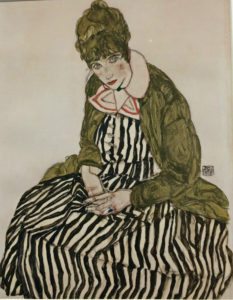 The Leopold Museum at Museumsquartier holds two exciting ‘Vienna 1900’ collections: The permanent exhibition Vienna ‘1900’and the world’s largest Egon Schiele collection in what many call the Egon Schiele Museum.
The Leopold Museum at Museumsquartier holds two exciting ‘Vienna 1900’ collections: The permanent exhibition Vienna ‘1900’and the world’s largest Egon Schiele collection in what many call the Egon Schiele Museum.
Seeing the Vienna 1900 exhibition early on will help you align the different ways Vienna expressed itself during this era. Expect richly ornamental fabrics next to stripped-bare human portraits. Likewise, prepare for contrasts such as mystically allegoric paintings next to functionalistic furniture, glass and silverware. Or sculptures such as a life-embracing curly-haired boy in white marble next to a faceless kneeling body.
Quite obviously, Egon Schiele’s portrays souls, not humans. Most have their faces and bodies bulged with anxiety and despair. While his art is raw and intense, it allows you to see the flipside of Vienna’s Imperial glamour.
Address: Leopold Museum at Museumsquartier, Museumsplatz 1, 1070 Vienna
Opening hours: Wednesday to Sunday, 10.00 am to 6.00 pm
Gustav Klimt At Vienna Secession
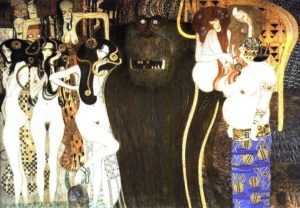 At its origins, Vienna 1900 is rooted in a white cubistic building ten minutes from Leopold Museum. Before you follow Gustav Klimt into the basement, wander around this odd box that forms the Vienna Secession. I love the groups of owls on the outer walls, the tortoises carrying the large mosaic vases at the entrance, and not least the gigantic globe formed of hundreds of golden leaves that crowns the building.
At its origins, Vienna 1900 is rooted in a white cubistic building ten minutes from Leopold Museum. Before you follow Gustav Klimt into the basement, wander around this odd box that forms the Vienna Secession. I love the groups of owls on the outer walls, the tortoises carrying the large mosaic vases at the entrance, and not least the gigantic globe formed of hundreds of golden leaves that crowns the building.
The basement unfolds more than 30 metres of Klimt’s frieze. It visualises German composer Richard Wagner’s interpretation of Beethoven’s Ninth Symphony: the suffering mankind encourages the well-shielded warrior to fight against the evil forces of nature. The human ‘genies’ (art, poetry, music) hover over them, until love fulfills mankind’s desire for happiness. I find the frieze powerful because it tells a universal story of the Good, the Bad and the Ugly (even Klimt’s Ugly look pretty good).
Address: Wiener Secession, Friedrichstraße 12, 1010 Vienna
Opening hours: Tuesday to Sunday, 2.00 pm to 6.00 pm
Otto Wagner At Naschmarkt
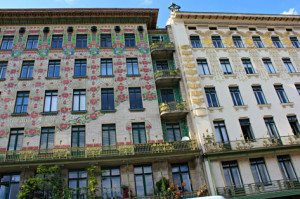 Linke Wienzeile is the place to go for Vienna 1900 architecture. The three buildings created by Art Nouveau and modernist architect Otto Wagner along Naschmarkt carry a strong lesson: ‘Simplify the structure, leave space for ornamental decoration.’ Baroque-style chubby cherubs, yearning madonnas and beefy atlases give way to glazed tiles, simple cascades of painted flowers, and cast iron balconies displaying neatly lined up leafage. Likewise, the female roof sculpture calling out to the market sellers beneath convinces by her sleek simple shape.
Linke Wienzeile is the place to go for Vienna 1900 architecture. The three buildings created by Art Nouveau and modernist architect Otto Wagner along Naschmarkt carry a strong lesson: ‘Simplify the structure, leave space for ornamental decoration.’ Baroque-style chubby cherubs, yearning madonnas and beefy atlases give way to glazed tiles, simple cascades of painted flowers, and cast iron balconies displaying neatly lined up leafage. Likewise, the female roof sculpture calling out to the market sellers beneath convinces by her sleek simple shape.
Read more about the houses in Otto Wagner.
By the way: Naschmarkt is a great place to stop for lunch.
Addresses: Linke Wienzeile 38 and 40 (Majolikahaus); Köstlergasse 3
Opening hours: The house at Linke Wienzeile now houses a bank (Bank Austria) on the ground floor, which you can visit during normal bank opening times; the rest is private property; The Majolikahaus is open 24 hours. Köstlergasse 3 is private property.
Klimt, Schiele And Kokoschka At National Gallery
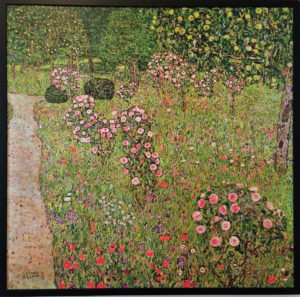 An aesthetic eroticist, an ‘enfant terrible’ and a savage: The National Gallery of Belvedere Palace exposes Vienna 1900: Compare Klimt’s otherworldly ladies wrapped in gold swirls and flowery ornaments with Schiele’s brute females exposing their wounded souls, and with Kokoschka’s intense portraits and landscapes. This place is probably the best to see two artistic perspectives of the world clash: those of the Viennese Secessionists (Gustav Klimt, Josef Maria Olbrich, Josef Hoffmann, Koloman Moser, and others) and those of the Expressionists (such as Egon Schiele, Oskar Kokoschka).
An aesthetic eroticist, an ‘enfant terrible’ and a savage: The National Gallery of Belvedere Palace exposes Vienna 1900: Compare Klimt’s otherworldly ladies wrapped in gold swirls and flowery ornaments with Schiele’s brute females exposing their wounded souls, and with Kokoschka’s intense portraits and landscapes. This place is probably the best to see two artistic perspectives of the world clash: those of the Viennese Secessionists (Gustav Klimt, Josef Maria Olbrich, Josef Hoffmann, Koloman Moser, and others) and those of the Expressionists (such as Egon Schiele, Oskar Kokoschka).
Don’t miss the Gallery’s key piece: Gustav Klimt’s ‘The Kiss’. (Visit the Klimt Villa to see his last studio.)
Address: Österreichische Nationalgalerie im Oberen Belvedere, Prinz-Eugen-Straße 27, 1030 Vienna
Opening hours: (from 1st July 2020) daily, 10.00 am to 6.00 pm
Stefan Zweig And Thonet At Café Central
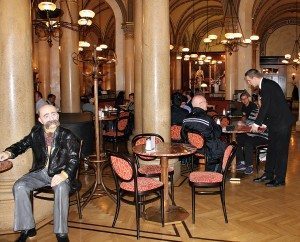 Fin de siècle writer Stefan Zweig not only portrayed Vienna’s tumultous changes at the turn of the century like no other. He was one of the key intellectuals of Vienna 1900’s vibrant coffeehouse culture. One of his favourite places was Café Central, where he wrote books and essays, and debated with contempory writers and artists such as Joseph Roth, Friedrich Torberg, Franz Kafka and others. You will also find another famous design item of that era there: the Thonet chair, that revolutionised affordable furniture for everyone and turned into a design icon of Vienna coffeehouses.
Fin de siècle writer Stefan Zweig not only portrayed Vienna’s tumultous changes at the turn of the century like no other. He was one of the key intellectuals of Vienna 1900’s vibrant coffeehouse culture. One of his favourite places was Café Central, where he wrote books and essays, and debated with contempory writers and artists such as Joseph Roth, Friedrich Torberg, Franz Kafka and others. You will also find another famous design item of that era there: the Thonet chair, that revolutionised affordable furniture for everyone and turned into a design icon of Vienna coffeehouses.
![]() My tip: Since the café offers an excellent menu of Viennese cuisine, stay there for dinner.
My tip: Since the café offers an excellent menu of Viennese cuisine, stay there for dinner.
Address: Café Central, Herrengasse 14, 1010 Vienna
Opening hours: (until further notice) Monday to Thursday 8.30 am to 05.30 pm, Friday and Saturday 08.30 am to 08.00 pm; Sunday and public holiday 10.00 am to 05.30 pm; closed on 24th December
Adolf Loos At Loos Bar
Vienna’s most prominent and landmarked fin-de-siecle bar goes on the account of much disputed architect Adolf Loos. Responsible for a list of shockingly bare buildings such as the bank opposite the Spanish Riding School, Loos measured a tiny 30 square metre bar that he filled with four tables, a counter, and onyx and marble panelled walls. Cleverly placed mirrors widen up the ceiling area. This is a wonderful place for an design-inspired chill out, but hold off (especially on week ends) if you are claustrophobic.
Address: Kärntner Durchgang 10, 1010 Vienna
Opening hours: daily, midday to 1.00 am
Mapped Out Itinerary I
To zoom in just click on the map to access Google Maps.
Vienna 1900: Day 2
Duration of walk including museum visits and a concert: 7 to 8 hours
Please note that you will need a car or public transport to travel to Otto Wagner’s church am Steinhof, but it’s so worth it.
Austrian Postal Savings Bank and Wagner Werk
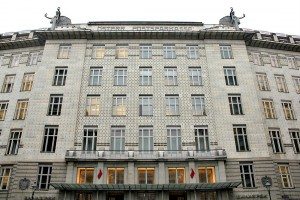 Although you may not have much banking to do while on a city break that shouldn’t prevent you from visiting Otto Wagner’s Austrian Postal Savings Bank. At first glance, the stern building looks ordinary, until you take a closer look. This is a ground breaking piece of modernist architecture in Vienna, if not in Europe. Inside the postal savings bank, not a single iron spike is left to occasional ugliness. Learn more about Wagner’s ultimate architectural statement in Austrian Postal Savings Bank.
Although you may not have much banking to do while on a city break that shouldn’t prevent you from visiting Otto Wagner’s Austrian Postal Savings Bank. At first glance, the stern building looks ordinary, until you take a closer look. This is a ground breaking piece of modernist architecture in Vienna, if not in Europe. Inside the postal savings bank, not a single iron spike is left to occasional ugliness. Learn more about Wagner’s ultimate architectural statement in Austrian Postal Savings Bank.
Address: Georg-Coch-Platz 2, 1010 Vienna
Opening hours: (great hall and Wagner Werk) Monday to Friday 10.00 am to 5.00 pm
Wiener Werkstätte At MAK
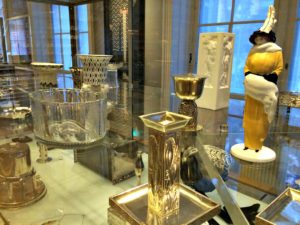 Whether you adore modernist furniture, have a hang for ornamental prints, love geometrical shapes or simply want to find out where Viennese classics end and modernist style starts: The Vienna 1900 permanent exhibition at the Museum of Applied Arts / Contemporary Art will sharpen your interest and knowledge.
Whether you adore modernist furniture, have a hang for ornamental prints, love geometrical shapes or simply want to find out where Viennese classics end and modernist style starts: The Vienna 1900 permanent exhibition at the Museum of Applied Arts / Contemporary Art will sharpen your interest and knowledge.
What I find most fascinating there is comparing the Secessionists’ flowery style to Modernist ‘practical-is-king’ creations. Equally, you will gain tremendous insight from tracing the Viennese style from Japanese arts and crafts and popular European art to where it starts to merge with international modernist styles.
Address: Museum für Angewandte Kunst, Stubenring 5, 1010 Vienna
Opening hours: Tuesday 10.00 am to 9.00 pm; Wednesday to Sunday 10.00am to 6.00pm; open on public holidays, including Mondays;
Otto Wagner At Church Am Steinhof
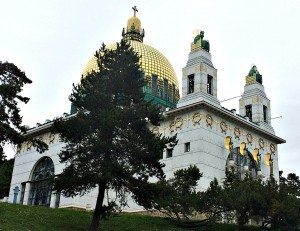 If you think you know how a European church looks like, take yourself a step further. Otto Wagner’s Kirche am Steinhof, the first modernist church in Europe, could be taken from an interior design magazine (if those ever covered churches).
If you think you know how a European church looks like, take yourself a step further. Otto Wagner’s Kirche am Steinhof, the first modernist church in Europe, could be taken from an interior design magazine (if those ever covered churches).
It teaches us a lesson about great church design, about feeling welcome, reassured and spirited. The church is off the beaten path, conceptually and logistically, and definitely worth the journey. I did a guided tour through the wonderful compounds of Steinhof where the church is located. Read more in Otto Wagner church.
Address: Kirche am Steinhof, Baumgartner Höhe 1, 1140 Vienna
Opening hours: (sightseeing) Saturday 4.00 to 5.00pm; Sunday midday to 4.00 pm;
Vienna 1900 Music At Wiener Konzerthaus
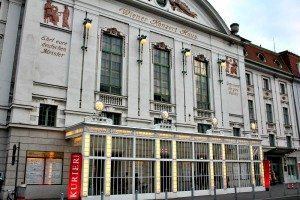 Like its art, Vienna 1900 music is controversial, pointing backwards and forwards in history, seducing and challenging. For example, take the sweet operetta melodies of Franz Léhar, Emmerich Kalman and Carl Michael Ziehrer that conjure Imperial traditions and values. (Go to Vienna musical and operetta calendar.)
Like its art, Vienna 1900 music is controversial, pointing backwards and forwards in history, seducing and challenging. For example, take the sweet operetta melodies of Franz Léhar, Emmerich Kalman and Carl Michael Ziehrer that conjure Imperial traditions and values. (Go to Vienna musical and operetta calendar.)
In contrast, the likes of Gustav Mahler, Alban Berg, Arnold Schönberg and Anton Webern is deep and complex, trying to express rather than please. Search for Gustav Mahler, Alban Berg, Arnold Schönberg, Anton Webern and other composers’ concert music in Vienna. (use ‘artist’ search box on the left in the link).
To listen to music in a grand Art Nouveau-style concert hall visit the Wiener Konzerthaus. Because of its (subdued) ornamental decorations it seems very Jugendstil, though the columns at the Grand Hall and other elements are clearly Historistic (very ‘Ringstrasse’). The geometrical lampshades in the foyer, the Tiffany windows and the decorated balcony of Mozart Saal will remind you of other modernist art in Vienna.
Address: Lothringer Straße 20, 1030 Vienna
Opening hours: (ticket and service center) Monday to Friday 9.00 am to 1.00 pm; most concerts start at 7.30 pm
Mapped Out Itinerary II
To zoom in just click on the map to access Google Maps.
Short Option: Guided Vienna Art Nouveau Walk
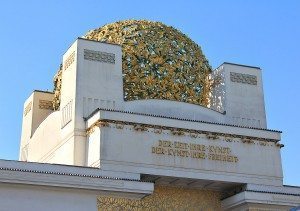 If you don’t have a full day for Vienna 1900 consider a guided small group walk that condenses the essence to three hours. The expert guide who conducts this Art Nouveau walk has a reputation of immersing people into the different art movements and their political and social backgrounds.
If you don’t have a full day for Vienna 1900 consider a guided small group walk that condenses the essence to three hours. The expert guide who conducts this Art Nouveau walk has a reputation of immersing people into the different art movements and their political and social backgrounds.
During your walk, he will take into accounts your individual interests, if you want to visit a museum, walk into a building or down a particular street. Find out more about this guided Vienna Art Nouveau walk. (photo: Vienna Secession’s ‘cabbage head’)
Jugendstil Shopping Tips
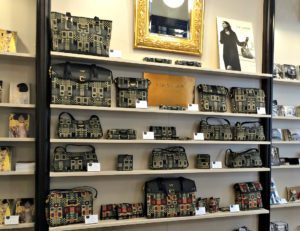 To go beyond Klimt mousepads a few shops in Vienna offer originals or authentic remakes of the best Vienna 1900 designs. Here are a few of the best objects to buy and where to find them in Vienna (the Vienna Shopping Guide has all the addresses).
To go beyond Klimt mousepads a few shops in Vienna offer originals or authentic remakes of the best Vienna 1900 designs. Here are a few of the best objects to buy and where to find them in Vienna (the Vienna Shopping Guide has all the addresses).
- bar set of glasses designed by Adolf Loos; from traditional glass manufacturer J.L. Lobmeyr (Kärntner Straße);
- Melon porcelain mocca service designed by Josef Hoffmann; from Augarten porcelain manufactory and MAK Design Shop;
- Ver Sacrum bags, wallets and scarves, based on a fabric design by Hoffmann (see photo); from Vienna 1900 store;
- glass vases based on designs by Josef Hoffmann; from Österreichische Werkstaetten;
- silver tableware based on designs by Hoffmann; from Wiener Silbermanufaktur and MAK Design Shop;
- 20th century decorative art such as paintings, drawings, glass and silverware; from Dorotheum auction house (over the counter);
- Jugendstil paintings, drawings, arts and crafts, vintage jewellery; occasional auctions at Dorotheum auction house.
explore other Vienna Walks
get more ideas of What To Do In Vienna
want my trip planning service for Vienna? Go to Vienna Travel Planning
back to Vienna Unwrapped homepage
